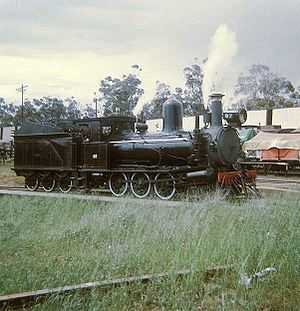South Australian Railways Y class
| South Australian Railways Y / Yx class[1] | |
|---|---|
|
Y Class loco at Jamestown in 1967 | |
| Type and origin | |
| Power type | Steam |
| Builder |
South Australian Railways, Islington Workshops Beyer Peacock, Manchester, England James Martin, Gawler, South Australia |
| Build date | 1885 |
| Total produced | 129 |
| Specifications | |
| Configuration | 2-6-0 |
| Gauge | 3 ft 6 in (1,067 mm) |
| Length | 39 ft 3 in (11.96 m) |
| Locomotive weight | 47 long tons 15 cwt (107,000 lb or 48.5 t) |
| Fuel type | Coal |
| Fuel capacity | 4 long tons 10 cwt (10,100 lb or 4.6 t) |
| Water capacity | 1,600 imperial gallons (7,300 l; 1,900 US gal) |
| Boiler pressure | 145 psi (1,000 kPa) |
| Cylinders | Two, outside |
| Cylinder size | 14.5 in × 20 in (0.37 m × 0.51 m) |
| Performance figures | |
| Tractive effort | 13,289 lbf (59.1 kN) |
| Career | |
| Operator(s) | South Australian Railways |
| First run | 1885 |
| Preserved | Y71, Y82, Yx86, Y97, Y109, Yx141 |
The Y class was a steam locomotive class built in South Australia for the South Australian Railways. In numbers built the Y class were the largest class of locomotives in the South Australian Railways history, 129 were built between 1885 and 1898. They worked on the narrow gauge network and performed general service on passenger and goods trains. Some members of the Y class were later upgraded and became the Yx class this work started in 1906, and progressed over many years until the 1950s.[1]
The initial order for 51 units was placed with Beyer, Peacock and Company of Manchester in England, another 77 were manufactured by James Martin & Co. of Gawler South Australia. Y 179 was the last built of the class and the first locomotive built at the Islington Workshops. The Y class were a variation on the narrow gauge mogul type, common at the time across all states of Australia, except Victoria.[2]
The Yx modifications added a new Belpaire boiler that allowed steam pressure to be set at 185 psi (1,276 kPa). The result was a more powerful locomotive.[3]
The class saw service across the entire narrow gauge network that included the Southern, Western, Northern and Eyre Peninsula regions of South Australia.[2]
Preserved units
- Y 97 is preserved in non working order at the National Railway Museum at Port Adelaide. Y97 was originally placed into service on 27 February 1890, and was withdrawn from revenue service on 14 May 1970.[2]
- Y 109 is on static display Manjimup, Western Australia
- Yx 141 is owned by Pichi Richi Railway and is under restoration at Quorn, South Australia, expected to be in working order during 2011
References
- ↑ 1.0 1.1 "Narrow Gauge Y/Yx". Website. ComRails. Retrieved 16 April 2011.
- ↑ 2.0 2.1 2.2 "Y97". Website. National Railway Museum. Retrieved 16 April 2011.
- ↑ "Class Yx". website. Steamlocomotive.com. Retrieved 16 April 2011.
| ||||||||||||||||||||||||||
